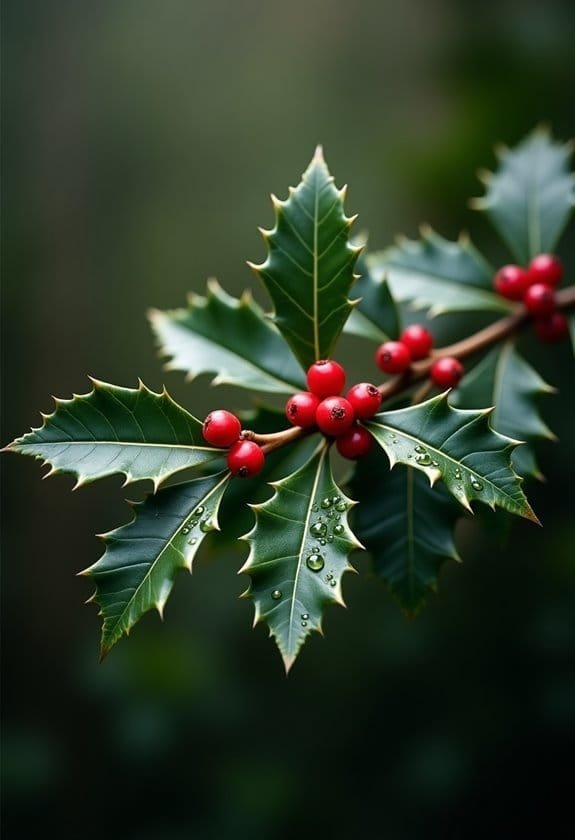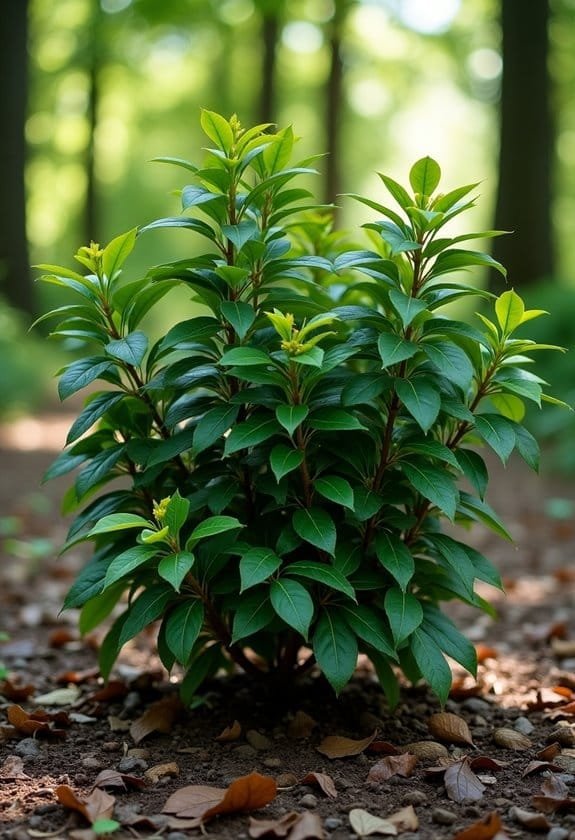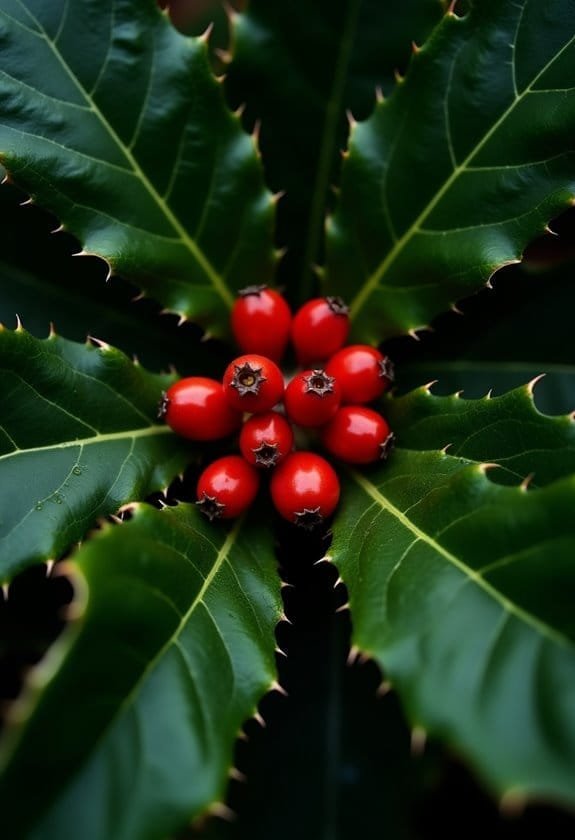Common Holly (Ilex aquifolium) is a majestic evergreen tree that grows 30-50 feet tall, featuring distinctive spiny-edged leaves and smooth, dark bark. It's renowned for its glossy dark green foliage and bright red berries, which appear on female plants after spring's white flower clusters. The species thrives in USDA zones 5-9, preferring well-drained soil and partial shade, though it can adapt to various light conditions. As a dioecious plant, it requires both male and female specimens for successful berry production, making it an essential resource for winter wildlife. Its rich cultural heritage and ecological significance offer fascinating layers of discovery.
Main Points
- Common Holly is an evergreen tree growing 30-50 feet tall with spiny-edged, glossy dark green leaves and red berries on female plants.
- Native to Europe, this dioecious plant requires both male and female specimens for successful berry production through pollination.
- Thrives in USDA zones 5-9, preferring well-drained soil and partial shade, with tolerance for temperatures as low as -20°F.
- Traditionally significant in winter celebrations, particularly Christmas, while providing essential food and shelter for wildlife year-round.
- Regular maintenance includes winter pruning, spring fertilization, and monitoring for common pests like leaf miners and scale insects.
Introduction

Common Holly (Ilex aquifolium) stands as one of Europe's most recognizable evergreen trees, featuring distinctive spiny-edged leaves and bright seasonal berries.
This majestic species, which belongs to the family Aquifoliaceae, can reach impressive heights of 30 to 50 feet while maintaining a broad spread of 15 to 25 feet at maturity.
Found naturally across Europe, North Africa, and Western Asia, the Common Holly has earned its place in both natural woodlands and cultivated landscapes, where it serves as an essential component of winter ecosystems through its provision of food and shelter for wildlife.
Common Name
Known worldwide as English holly, Christmas holly, or European holly, Ilex aquifolium stands as one of winter's most recognizable plants. The common holly's name carries a rich linguistic heritage, deriving from the Old English word "holegn," which has evolved through centuries of cultural and botanical significance.
This evergreen species has become deeply woven into winter traditions, particularly in European and North American celebrations. The plant's various common names reflect both its geographical origins and cultural importance, with "English holly" highlighting its prominence in British landscapes and "Christmas holly" emphasizing its role in yuletide decorations.
Throughout history, common holly has transcended its botanical classification to become a powerful symbol of protection and celebration, particularly during the winter months. Its widespread recognition stems from distinctive features like glossy, spined leaves and brilliant berries, which have made it instantly identifiable across different cultures.
While botanically known as Ilex aquifolium, the plant's common names have become deeply embedded in holiday traditions, literature, and folklore, cementing its status as a cultural icon beyond mere botanical designation.
Scientific Name
Scientifically identified as Ilex aquifolium, this majestic evergreen species was first described by Carl Linnaeus in 1753, establishing its formal taxonomic classification. The plant belongs to the family Aquifoliaceae, which encompasses numerous holly species distributed across various temperate and subtropical regions worldwide.
The binomial nomenclature of Ilex aquifolium reflects its distinctive characteristics, with "Ilex" being the genus name derived from the ancient Roman name for holly, while "aquifolium" refers to its pointed, spiny leaves. This scientific designation plays a critical role in distinguishing it from other holly species and guarantees precise identification in botanical research and cultivation.
As a dioecious plant, Ilex aquifolium exhibits separate male and female specimens, a characteristic that considerably influences its reproductive strategy and population dynamics.
The species produces vibrant drupes containing three to four seeds, which typically reach maturity during the autumn months of October and November, making it an essential food source for various wildlife species throughout its native range in Europe, North Africa, and western Asia.
Overview
Standing as one of Europe's most iconic evergreen trees, Ilex aquifolium, or common holly, combines striking ornamental features with significant ecological value. This distinctive evergreen tree or shrub showcases a commanding presence in landscapes, reaching impressive heights of 30 to 50 feet while maintaining an elegant pyramidal form.
The holly's most recognizable features are its glossy, leathery leaves, which measure between 1 to 3 inches in length and display characteristic spiny margins that adapt to environmental conditions. As a dioecious species, male and female flowers develop on separate plants, with delicate white blooms emerging in spring before transforming into vibrant red or yellow drupes during autumn months.
Native to diverse regions spanning Europe, North Africa, and Western Asia, this adaptable species flourishes in well-drained, moist soils within woodland environments and hedgerows.
Beyond its traditional role in holiday decorations and ornamental landscaping, the common holly serves as a crucial component of local ecosystems, providing essential shelter and sustenance for wildlife throughout its natural range.
Key Features
The English holly stands as a majestic evergreen, reaching impressive heights of 30 to 50 feet with a distinctive pyramidal crown spanning 15 to 25 feet wide.
Its signature dark green leaves showcase a glossy, leathery texture and feature spiny margins that vary in their prickliness depending on environmental conditions.
The plant's dioecious nature reveals itself each spring when fragrant white flowers emerge on separate male and female trees, setting the stage for bright red or yellow drupes that appear in late autumn.
Growth Size
As one of the larger evergreen shrubs in its family, common holly reaches impressive heights of 30 to 50 feet with a substantial spread of 15 to 25 feet at maturity. This stately tree exhibits a distinctly pyramidal growth pattern, creating a broad conical silhouette that commands attention in any landscape setting.
The plant's growth size is complemented by its dense branching structure, which contributes to its robust appearance and provides excellent screening capabilities. While its growth rate is moderate, common holly's remarkable longevity allows it to develop into a magnificent specimen over time, with some trees surviving up to three centuries under ideal conditions.
The plant's ultimate dimensions are influenced by environmental factors, including soil quality and moisture levels, though it demonstrates notable adaptability to various growing conditions.
Despite its potentially imposing size, common holly maintains a well-proportioned form throughout its development, with its characteristic dark green, spiny leaves measuring 1 to 3 inches in length creating a harmonious balance between the plant's substantial height and its detailed foliar features.
Appearance
Common Holly's striking visual characteristics extend far beyond its impressive size. The tree's most distinctive feature is its foliage, which consists of glossy, dark green leaves measuring between 1 to 3 inches in length, with sharp spiny margins and an undulating texture that creates a dramatic silhouette against the winter sky.
The tree's exterior is further distinguished by its smooth bark, which exhibits a rich range of dark colors from black to deep gray, developing small brown warts as the plant matures.
During spring, the holly's branches come alive with clusters of delicate white flowers, which release a subtle yet pleasant fragrance that attracts pollinators. Since Common Holly is dioecious, these blooms appear separately on male and female plants, with only the latter producing the iconic fruits.
The female specimens transform dramatically in autumn, when bright drupes, typically red but occasionally yellow, emerge among the evergreen foliage. These berries, which contain three to four seeds each, create a striking contrast against the dark leaves and contribute to the plant's enduring ornamental appeal throughout the winter months.
Flowering Season
During early spring through early summer, flowering bursts into life across Common Holly specimens, reaching peak bloom in May when clusters of delicate white blossoms emerge.
These aromatic flowers, measuring approximately one inch, play a vital role in the plant's reproductive cycle, drawing pollinators to their
Growing Requirements

Common Holly's growing requirements center on its need for well-drained, humus-rich soil and a location that receives full to partial sunlight throughout.
Light
Light plays an essential role in the successful cultivation of Ilex aquifolium, which requires at least four hours of direct sunlight daily for optimal growth. These evergreen trees demonstrate remarkable adaptability to varying light conditions, though they perform best in locations that balance sun exposure with partial shade.
While common holly can flourish in woodland settings where dappled sunlight filters through the canopy, insufficient light exposure often results in compromised growth patterns and reduced berry production. The plant's relationship with light directly influences its ornamental value, as inadequate sunshine can lead to sparse foliage development and diminished overall vigor.
In regions with hot, humid summers, providing partial shade during intense afternoon hours helps protect the holly while still ensuring adequate light for photosynthesis. Gardeners should carefully consider light patterns throughout the seasons when selecting planting locations, as the holly's year-round presence demands consistent light management.
Strategic positioning near deciduous trees can create ideal conditions, offering protection during summer while allowing increased light penetration during winter months when deciduous leaves have fallen.
Soil
The soil requirements for Ilex aquifolium greatly influence its growth success and long-term health. This species demonstrates a marked preference for well-drained, organic-rich soils that maintain consistent moisture levels throughout the growing season.
While adaptable to varying soil conditions, Common Holly performs ideally in locations where organic matter has been thoroughly incorporated into the growing medium.
The plant's versatility extends to its pH tolerance, thriving in both acidic and mildly alkaline environments, which contributes to its widespread cultivation success.
However, proper drainage remains essential, as waterlogged conditions can severely compromise root health and lead to devastating fungal infections.
Young holly specimens particularly benefit from soil that strikes a perfect balance between moisture retention and drainage capability. For best establishment, gardeners should focus on creating a soil environment that mimics the plant's natural woodland habitat, where leaf litter and organic debris naturally enrich the ground.
This approach supports the development of a robust root system, which becomes increasingly important during periods of drought stress, even though established plants demonstrate considerable drought tolerance.
Water
Proper watering practices complement well-structured soil conditions for maintaining healthy Ilex aquifolium specimens. Regular monitoring of soil moisture levels proves essential, particularly during periods of drought when these woodland plants may experience considerable stress without adequate hydration.
The plant's natural preference for well-drained, moist environments reflects its woodland heritage, where consistent moisture levels typically prevail beneath the canopy.
During hot, humid summer months, Common Holly requires careful attention to its watering regime, as both overwatering and underwatering can compromise its health. While the species demonstrates remarkable resilience in various conditions, maintaining consistent soil moisture helps prevent issues such as leaf drop and stunted growth.
Experienced gardeners often implement a strategic watering schedule that allows the top layer of soil to dry slightly between waterings, while ensuring deeper soil layers retain adequate moisture. This approach mirrors the plant's natural habitat conditions and promotes robust root development.
Regular inspection of the soil's moisture content, particularly during the plant's active growing season, enables gardeners to adjust watering frequency in response to environmental conditions and the specimen's specific needs.
Temperature
Successfully maintaining Ilex aquifolium requires careful consideration of temperature conditions, as this species thrives in mild to cool climates within USDA hardiness zones 5 through 9. This resilient native plant demonstrates remarkable cold tolerance, withstanding winter temperatures as low as -20°F (-29°C) in suitable environments, while maintaining its characteristic evergreen foliage.
During the warmer months, Common holly exhibits a distinct preference for moderate temperatures, particularly avoiding hot, humid conditions that can stress the plant and potentially contribute to root-related issues.
In its natural habitat, this adaptable species flourishes in woodland settings where ambient temperatures remain relatively stable through canopy protection. While the plant demonstrates impressive drought tolerance during summer months, excessive heat combined with poor drainage can compromise its health and vigor.
For ideal growth, gardeners should position Ilex aquifolium in locations that provide some afternoon shade in warmer regions, creating a microclimate that mimics its preferred growing conditions. This strategic placement helps maintain appropriate temperature levels and supports the plant's natural cooling mechanisms, particularly during periods of intense summer heat.
Pollinator Criteria
Common Holly's pollination system relies on a fascinating partnership between plants and insects, with its small white flowers attracting various pollinators, particularly bees and butterflies seeking nectar rewards.
The plant's dioecious nature requires both male and female specimens for successful reproduction, as these insects transport pollen between separate plants during their foraging activities.
The specialized relationship between Common Holly and certain pollinators, especially the Colletes banksi bee, demonstrates the plant's integral role in supporting local biodiversity and maintaining ecological balance.
Attracted Pollinators
The allure of Common Holly's small white flowers attracts numerous pollinator species during its spring flowering period. Among the diverse array of visitors, bees, wasps, and butterflies are particularly drawn to the fragrant blooms, which serve as important nectar sources during the early growing season.
The plant's dioecious nature, with male and female flowers growing on separate plants, creates an intricate ecological dance that guarantees successful pollination. This reproductive strategy encourages pollinators to move between plants, facilitating cross-pollination and genetic diversity within holly populations.
Of particular interest is the specialized relationship between Common Holly and Colletes banksi, a bee species that demonstrates a strong affinity for these flowering plants.
The successful pollination of female flowers by these industrious insects ultimately leads to the development of bright red berries, which become significant food sources for local bird populations.
This interconnected relationship highlights the essential role that Common Holly plays in supporting both pollinator communities and the broader ecosystem, creating a chain of ecological benefits that extends throughout the growing season.
Pollination Method
While pollinators flock to Common Holly's flowers, specific conditions must align for successful reproduction. The plant's dioecious nature requires the presence of both male and female plants in relatively close proximity, as each maintains its distinct reproductive role in the species' continuation.
During early spring, clusters of small, white flowers emerge, attracting industrious pollinators with their sweet nectar and delicate fragrance. Bees, nature's most efficient couriers, transfer pollen between male and female plants, though the process isn't entirely straightforward.
Male plants possess hermaphroditic flowers capable of self-pollination, which guarantees a steady supply of pollen for neighboring female specimens.
The intricate dance of pollination culminates in autumn, when successfully fertilized female plants develop vibrant red drupes. These fruits, maturing between October and November, represent the culmination of the spring's pollination efforts, providing essential sustenance for wildlife while guaranteeing the next generation of holly through seed dispersal.
This carefully orchestrated process demonstrates the remarkable precision of natural reproductive systems.
Care & Maintenance

Successful holly cultivation begins with selecting a well-drained planting site that receives adequate sunlight and preparing the soil with organic matter for ideal root development.
Regular maintenance involves strategic pruning in late winter, consistent mulching to retain moisture, and applying balanced fertilizer in early spring to promote vigorous growth and abundant berry production.
Gardeners often find that holly thrives alongside companion plants like boxwood and yew, which share similar soil preferences and create an attractive year-round display of varied textures and heights.
Planting Tips
Properly planting common holly requires careful timing and attention to prime growing conditions. Success begins with selecting the ideal planting period during the plant's dormancy, which spans from mid-November through late April when the holly's metabolic processes have naturally slowed.
When implementing essential planting tips, gardeners should prioritize location selection that offers well-drained, moist soils enriched with organic humus.
The planting site must receive adequate sunlight, ranging from full exposure to partial shade, which enables the holly to develop its characteristic glossy leaves.
Ongoing Care
Maintaining common holly requires consistent attention to several key aspects of care throughout the growing season.
Regular watering is essential, especially during dry spells. Holly plants prefer well-drained soil, so ensure that the roots do not sit in water.
Fertilizing should be done in early spring with a balanced fertilizer to promote healthy growth. This will help the plant thrive and produce vibrant foliage.
Pruning is also important to maintain the shape and health of the holly. Remove any dead or damaged branches and trim back overgrown areas to encourage new growth.
Lastly, keep an eye out for pests and diseases. Early detection and treatment can prevent serious damage to the plant.
Suggested Companions
When choosing companion plants for Common Holly, several shade-tolerant species work harmoniously to create an appealing landscape while sharing similar care requirements. Ferns and shade-tolerant perennials naturally complement Holly's evergreen foliage, thriving beneath its protective canopy while adding textural diversity to the garden space.
Native plants like dogwood and serviceberry make excellent companions, as they support local wildlife populations and create a balanced ecosystem alongside Holly. These species provide additional food sources through their berries and flowers, while their maintenance schedules align well with Holly's pruning requirements.
Boxwood and azaleas have proven particularly successful as companion plants, as they can withstand Holly's dense growth patterns and spiny foliage while maintaining their own distinct presence in the landscape.
To optimize growth conditions for both Holly and its companions, applying a layer of mulch around the plantings helps retain soil moisture and suppress unwanted weed growth. This practice
How Does Common Ivy Affect the Growth or Health of Common Holly?
The common ivy plant can significantly impact the growth of common holly by competing for sunlight, water, and nutrients. As it spreads, it may climb holly trees, potentially smothering their branches and limiting photosynthesis. This competition can weaken the holly’s health over time, especially in areas with limited resources.
Common Issues
Common holly faces several notable challenges, including the destructive leaf-mining insect Phytomyza ilicis, which creates unsightly tunnels through the foliage and compromises plant health.
While toxic berries pose risks to humans and pets, gardeners must also contend with the plant's invasive tendencies in certain regions, requiring vigilant monitoring and control measures.
Effective management typically involves combining targeted herbicide applications with manual removal techniques, though persistent re-sprouting can make complete eradication particularly challenging in established specimens.
Pests/Diseases
Despite its hardy nature, Ilex aquifolium faces several important pest and disease challenges. Fungal pathogens can cause devastating leaf blight and spotting, which often results in premature leaf drop and compromises the plant's overall vitality.
Additionally, persistent aphid infestations pose a serious threat, as these tiny pests feed voraciously on plant sap, leading to distorted growth and weakened foliage.
One particularly troublesome invader is the leaf-mining insect Phytomyza ilicis, which creates intricate tunnels within the leaves, causing unsightly discoloration and structural damage.
Scale insects present another formidable challenge, as they not only drain the plant's resources but also secrete honeydew, which becomes a breeding ground for sooty mold development. The presence of this sticky substance can greatly impair the holly's photosynthetic capabilities and aesthetic appeal.
Fortunately, proper cultural practices can help mitigate these issues. Ensuring adequate air circulation around the plant and implementing appropriate watering schedules creates an environment less conducive to fungal growth and pest proliferation.
Regular monitoring and early intervention remain essential for maintaining healthy holly specimens.
Solutions
Several effective solutions exist for managing common holly issues, particularly in regions where it's considered invasive.
In King County, Washington, where English holly has been designated as a target for State Noxious Weed Control programs, various management strategies have proven successful in controlling its spread.
Summary

As one of Europe's most recognizable evergreen trees, Ilex aquifolium (English holly) stands out with its glossy dark green leaves and bright red berries. This dioecious species, where only female plants produce the distinctive fruits, has been used extensively in ornamental landscaping and traditional holiday decorations for centuries.
Growing up to 50 feet tall, English holly demonstrates remarkable adaptability to various light conditions, though it performs best in well-drained soils with partial to full sun exposure. The species' distinctive spiny-margined leaves and vibrant drupes have inspired the development of over 200 cultivars, each selected for specific ornamental qualities and growing characteristics.
While the plant's berries pose toxicity risks to humans, they serve as an essential food source for winter birds, highlighting the species' ecological significance.
However, its vigorous growth habits have led to concerns about invasiveness in certain regions of the United States. Despite these challenges, Ilex aquifolium continues to play an important role in both managed landscapes and natural ecosystems, particularly in its native range across Europe, North Africa, and Western Asia.


